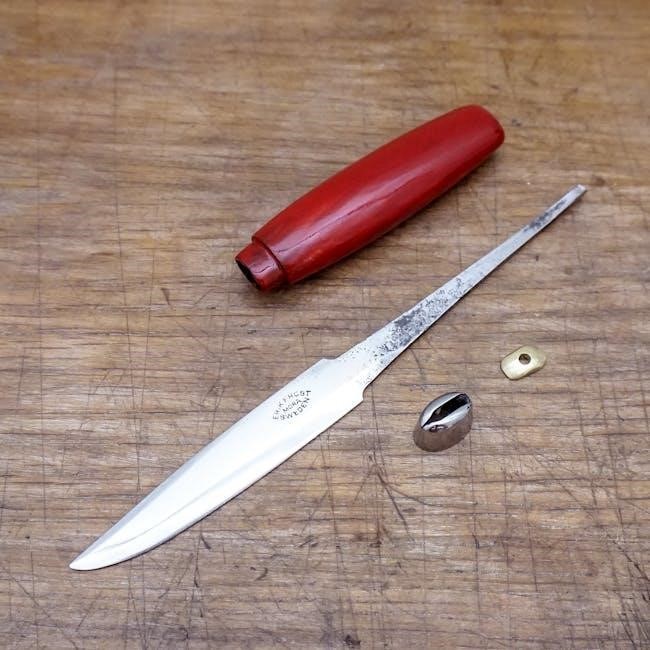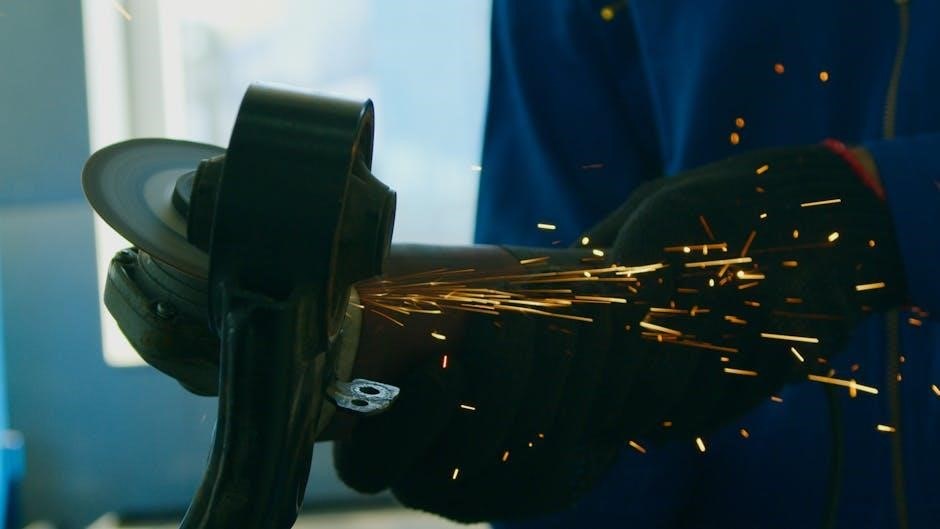
manual key cutting tool
Manual key cutting tools are essential devices for duplicating keys, offering precision and control. They are versatile, suitable for both professionals and DIY enthusiasts, enabling cost-effective key duplication while empowering users to develop a valuable skill.
1.1 Definition and Purpose
Manual key cutting tools are devices designed to duplicate keys by shaping key blanks to match the original key’s profile. These tools require manual operation, relying on the user’s skill and precision to create accurate key copies. Their primary purpose is to enable individuals, whether professionals or DIY enthusiasts, to produce functional keys without reliance on automated systems. By using manual tools, users can achieve cost-effective solutions for key duplication, while also developing a practical skill. These tools are essential for locksmiths, homeowners, and anyone needing to create spare or replacement keys, offering a hands-on approach to key duplication.
1.2 Benefits of Using Manual Key Cutting Tools
Manual key cutting tools offer numerous advantages, including cost-effectiveness and portability. They provide an affordable alternative to automatic machines, making them ideal for small-scale or personal use. These tools empower users to duplicate keys independently, saving time and money. Their compact design allows for easy storage and transport, perfect for on-the-go use. Manual tools also serve as a valuable skill-building resource, enabling users to develop precision and dexterity. Additionally, they are environmentally friendly, reducing reliance on electricity. Overall, manual key cutting tools are a practical and efficient solution for key duplication, suitable for both professionals and DIY enthusiasts seeking to enhance their self-sufficiency.

Types of Manual Key Cutting Tools
Manual key cutting tools include hand-held machines, pliers, and files, each designed for precision and ease of use, catering to various skill levels and key types.
2.1 Hand-Held Key Cutting Machines
Hand-held key cutting machines are portable devices designed for precise key duplication. They feature a rotating blade that shapes key blanks to match the original key’s profile. Available in manual and electric versions, these machines are ideal for cutting house, car, and specialized keys. The manual version requires the user to rotate the blade, while electric models use a motor for ease. Equipped with clamping systems and depth gauges, they ensure accurate cuts. These machines are popular among locksmiths and DIY enthusiasts for their balance of precision and ease of use, making them suitable for both simple and complex key types.
2.2 Key Cutting Pliers
Key cutting pliers, or nippers, are a basic yet effective tool for manual key duplication. These portable devices cut key blanks by applying pressure to the cutting edges, typically made of hardened steel. They are ideal for simpler key profiles, such as house or padlock keys. Available in various sizes, key cutting pliers often feature adjustable jaws for precise alignment and depth gauges for consistent cuts. While less precise than hand-held machines, they offer affordability and portability, making them a practical choice for emergencies or quick key copies. However, they require a steady hand and experience to achieve accurate results, making them best for basic key duplication tasks.
2.3 Key Cutting Files
Key cutting files, also known as key rasps, are the most basic manual key cutting tools. These small, specialized files are designed to shape and cut key blanks with precision. Available in various shapes—flat, round, and half-round—they cater to different key profiles and cutting depths. Using key cutting files requires patience, skill, and a steady hand, as the process involves gradually shaping the key blank to match the original key’s profile. Despite being time-consuming, they are highly versatile, portable, and affordable, making them ideal for DIY enthusiasts and on-the-go key cutting. Mastery of key cutting files demands practice and attention to detail, but they remain a reliable option for basic key duplication tasks.

Factors to Consider When Choosing a Manual Key Cutting Tool
Key factors include skill level, key type, budget, and portability. These elements ensure the right tool is selected for precise, efficient, and cost-effective key duplication.
3.1 Skill Level and Experience
Skill level and experience are critical when selecting a manual key cutting tool. Beginners may find hand-held machines more user-friendly, offering precision and ease of use. Intermediate users often prefer key cutting pliers, which require a steadier hand but are portable and cost-effective. Advanced individuals may opt for key cutting files, which demand high precision and skill for intricate cuts. Matching the tool to your expertise ensures efficient and accurate key duplication. Starting with simpler tools and progressing as skills improve is recommended. Proper technique and practice are essential for mastering any manual key cutting tool, regardless of experience level.
3.2 Type of Keys to be Cut
Manual key cutting tools are versatile, catering to various key types, including house keys, car keys, and specialized keys like flat or dimple keys. The tool selection depends on the key’s complexity and profile.
For simpler keys, such as standard house keys, basic tools like key cutting pliers or files suffice. However, for complex keys, like car keys with intricate cuts, hand-held machines or specialized tools are necessary. Ensuring the tool matches the key type guarantees accurate duplication and proper functionality. This consideration is vital for achieving professional-quality results, whether for everyday use or specialized applications. Always choose a tool designed for the specific key type to ensure precision and effectiveness in the cutting process.
3.3 Budget Considerations
Budget plays a significant role in selecting manual key cutting tools, as options range from affordable to professional-grade. Basic tools like key cutting files or pliers are budget-friendly, ideal for occasional use or DIY projects. Mid-range hand-held machines offer better precision and durability, suitable for frequent key duplication. High-end tools, such as advanced manual key cutting machines, are designed for professionals and heavy-duty use, offering superior accuracy and versatility. Assessing your needs and frequency of use helps determine the best investment. While higher-priced tools provide long-term benefits, affordable options can suffice for basic tasks, ensuring cost-effectiveness without compromising on essential functionality.

Safety Precautions When Using Manual Key Cutting Tools
Always wear safety glasses and gloves when using manual key cutting tools to protect against metal shavings and sharp edges. Ensure a well-lit workspace and avoid distractions.
4.1 Workspace Setup and Safety Gear
Setting up a safe workspace is crucial when using manual key cutting tools. Ensure the area is well-lit, clear of obstructions, and free from distractions. Always wear safety glasses to protect your eyes from flying metal shavings and gloves to prevent cuts and scrapes. Secure the key cutting machine or tools firmly on a stable workbench to avoid accidental movement. Keep loose clothing and long hair tied back to prevent entanglement. Avoid working near children or pets, and never use excessive force, which can lead to tool damage or injury. Regularly inspect tools for wear and tear, replacing them as needed.
4.2 Handling Sharp Tools and Avoiding Accidents
Handling sharp tools requires caution to prevent accidents. Always maintain a firm grip on tools to avoid slippage and keep fingers away from cutting edges. Avoid applying excessive force, as it can lead to tool damage or injury. Regularly inspect tools for sharpness and wear; dull tools are more hazardous as they require more force. Store tools in a secure, dry place to prevent rust and maintain functionality. In case of an accident, have a first aid kit nearby. Proper handling and maintenance of sharp tools ensure safety and efficiency in key cutting tasks, reducing risks and improving overall results.

Step-by-Step Key Cutting Process
The process involves aligning the key blank with the original, securing it, and making precise cuts. Testing the key ensures proper functionality, guaranteeing accuracy and reliability in duplication.
5.1 Aligning the Key Blank with the Original Key
Aligning the key blank with the original key is crucial for accuracy. Place both keys together, ensuring their profiles match perfectly. Use a jig or clamp to secure them, preventing movement during cutting. Proper alignment guarantees the duplicate key will fit and function correctly in the lock, minimizing errors and the need for adjustments. This step requires patience and attention to detail to ensure the blank mirrors the original key’s shape and dimensions precisely.
5.2 Securing the Key in the Cutting Tool
Securing the key in the cutting tool is essential for accurate duplication. Clamp or mount the original key alongside the blank in the tool’s alignment jig. Ensure both keys are flush and evenly positioned. Tighten the clamp firmly to prevent movement during cutting. For hand-held machines, use a vice to stabilize the tool, while for pliers, grip the keys securely. Proper clamping ensures precise cuts and avoids damage to the tool or keys. Double-check the alignment before proceeding to guarantee a flawless duplication process. A secure hold is critical for maintaining control and achieving professional-quality results.
5.3 Making Precise Cuts and Adjustments
Making precise cuts and adjustments is crucial for creating a functional key. Use the cutting tool to carefully replicate the original key’s profile, ensuring each cut aligns perfectly. For hand-held machines, apply steady, controlled motions, while files require patience and a light touch. Gradually remove material, checking progress frequently to avoid overcutting. Regularly compare the cut key with the original to ensure accuracy. Fine-tune the edges and depths as needed for a smooth fit. Precision is key to a properly functioning key, so attention to detail is vital throughout the process.
5.4 Testing the Cut Key in the Lock
Testing the cut key in the lock is the final step to ensure its functionality. Insert the key gently and turn it to check the fit and smoothness. If it doesn’t fit perfectly, make minor adjustments using a file or key file. Pay attention to the key’s edges and teeth, as small imperfections can hinder proper operation. Repeat the process until the key operates the lock effortlessly. Patience and attention to detail are crucial for achieving a precise fit. Once the key turns smoothly and engages the lock mechanism without resistance, you’ve successfully created a reliable duplicate key.

Maintenance and Care of Manual Key Cutting Tools
Regularly clean tools to remove metal shavings and lubricate moving parts to prevent rust. Store tools in a dry, organized space to maintain their functionality and longevity.
6.1 Cleaning and Lubricating the Tools
Cleaning and lubricating manual key cutting tools are crucial for maintaining their performance and longevity. After each use, remove metal shavings and debris with a soft-bristled brush or a clean, dry cloth. For intricate parts, a compressed air canister can be effective. Lubricate moving components, such as hinges and blades, with a silicone-based spray to prevent rust and ensure smooth operation. Regularly inspect tools for signs of wear or damage and replace worn parts immediately. Proper maintenance not only extends the life of your tools but also ensures precise and consistent key cuts. Consistency in care will keep your tools functioning optimally for years.
6.2 Proper Storage and Organization
Proper storage and organization of manual key cutting tools are essential for maintaining their condition and accessibility. Store tools in a dry, clean environment, away from direct sunlight and moisture. Use protective cases or toolboxes with individual compartments to prevent damage and keep tools organized. Label each compartment for easy identification, ensuring tools are quickly accessible when needed. For frequently used tools, consider a designated workspace with a pegboard or drawer organizer. Regularly inspect stored tools for rust or wear, addressing issues promptly. A well-organized setup not only protects your tools but also enhances efficiency and reduces the risk of misplacement. Proper storage extends tool life and maintains workplace order.
6.3 Sharpening and Replacing Cutting Blades
Sharpening and replacing cutting blades are crucial for maintaining the performance of manual key cutting tools. Regular sharpening ensures precise cuts and extends blade life. Use a high-quality sharpening stone or grinder, following the manufacturer’s angle and technique guidelines. Inspect blades for wear or damage; if sharpening no longer restores effectiveness, replace them promptly. Replacement blades should match the tool’s specifications exactly to maintain accuracy and functionality. Properly dispose of dull or damaged blades to avoid accidents. Regular maintenance of cutting blades ensures consistent key cutting quality and prevents costly repairs or rework. Keep spare blades on hand to minimize downtime during projects.

Common Mistakes to Avoid
Common mistakes include improper key blank alignment, overcutting, and using incorrect tools, leading to poor key functionality. Avoiding these ensures precise and functional key duplicates.
7.1 Improper Alignment of the Key Blank
Improper alignment of the key blank is a common mistake that can lead to inaccurate key cuts. Misalignment occurs when the key blank is not correctly positioned relative to the original key, resulting in uneven or mismatched cuts. This can cause the key to fail to operate smoothly in the lock, requiring costly rework or replacement. To avoid this, ensure the key blank is securely clamped and aligned with the original key before cutting. Using a jig or alignment guide can help maintain proper positioning. Regularly checking the alignment during the cutting process also minimizes errors and ensures a precise final product.
7.2 Overcutting or Undercutting the Key
Overcutting or undercutting a key are common mistakes that can render the key unusable. Overcutting removes too much material, altering the key’s profile and preventing it from fitting the lock properly. Undercutting, conversely, leaves too much material, resulting in a key that doesn’t engage the lock mechanism effectively. Both errors stem from improper blade depth settings or excessive force during cutting. To avoid these issues, use a depth gauge and apply steady, controlled pressure. Regularly inspecting the key during the cutting process can help catch and correct such mistakes early, ensuring a precise and functional final product.
7.3 Using the Wrong Tool for the Key Type
Using the wrong tool for the key type is a significant mistake that can lead to inaccurate cuts and potential damage to the key or tool. For instance, using pliers designed for house keys on car keys can result in improper shaping and render the key useless. Similarly, employing a basic file for complex key profiles may fail to achieve the required precision. Always ensure the tool matches the key type, whether it’s for house, car, or specialized keys. This prevents wasted time, material, and tool damage. Selecting the right tool for the job is crucial for achieving a functional and precise key duplicate.

Market Outlook for Manual Key Cutting Tools
The global manual key cutting tools market, valued at $1.8 billion in 2022, is projected to reach $2.8 billion by 2031, growing at a CAGR of 5.1%.
8.1 Global Market Trends

The global market for manual key cutting tools is experiencing steady growth, driven by increasing demand in developing regions. The U.S. leads North America’s rapid expansion, with the market valued at $1.8 billion in 2022 and projected to reach $2.8 billion by 2031, growing at a 5.1% CAGR. Emerging economies are adopting manual tools for cost-effective solutions, while developed markets see sustained demand from locksmiths and DIY enthusiasts. The rise in DIY culture and availability of affordable, portable tools further fuel market growth, making manual key cutting tools a viable choice for both professionals and hobbyists worldwide.
8.2 Growth Projections and Industry Insights
The manual key cutting tool market is poised for significant expansion, with a projected CAGR of 5.1% from 2023 to 2031. Industry insights reveal a growing preference for portable and cost-effective tools, particularly in emerging markets. Locksmiths and DIY enthusiasts drive demand, while technological advancements in tool design enhance precision and user-friendliness. The market’s growth is further supported by increasing awareness of manual tools’ benefits, such as affordability and ease of use, making them a popular choice for both professional and personal use. This trend underscores a promising future for manual key cutting tools in a competitive landscape.

Comparison with Automatic Key Cutting Machines
Manual key cutting tools offer portability and cost-effectiveness, ideal for DIY projects, while automatic machines provide faster, precise cuts but are more expensive and less portable.
9.1 Precision and Speed
Manual key cutting tools require skill and patience, offering decent precision but at a slower pace. Automatic machines, while more expensive, deliver faster and highly accurate cuts, ideal for professionals needing efficiency. Manual tools suit DIY enthusiasts for occasional use, while automatic machines are better for high-volume key production. The choice depends on balancing speed, precision, and budget, catering to different user needs and preferences effectively.
9.2 Cost and Accessibility
Manual key cutting tools are generally more affordable and accessible compared to automatic machines, making them a popular choice for hobbyists and small-scale professionals. They require minimal initial investment and are widely available in hardware stores and online. Automatic machines, while offering superior precision, are typically more expensive and complex, limiting their accessibility for casual users. Manual tools are ideal for those seeking a cost-effective solution for occasional key duplication, providing a practical entry point for newcomers. Their portability and ease of use further enhance their accessibility, allowing users to cut keys without needing dedicated workspace or advanced technical expertise.
9.3 Use Cases for Each Type
Manual key cutting tools are ideal for DIY enthusiasts, small locksmith businesses, and emergency situations where portability is essential. They are cost-effective for occasional use, making them perfect for homeowners and hobbyists. Automatic key cutting machines, however, are better suited for high-volume tasks and professional locksmiths requiring precision and speed. Manual tools excel in simplicity and affordability, while automatic machines cater to complex, high-precision needs. Choosing the right type depends on the user’s skill level, budget, and the frequency of key cutting tasks, ensuring optimal efficiency and productivity in various scenarios.
Manual key cutting tools empower users with cost-effective, convenient key duplication, fostering self-reliance and savings. They are perfect for DIY enthusiasts and professionals alike, offering lasting value.
10.1 Summary of Key Points
Manual key cutting tools are versatile, cost-effective solutions for duplicating keys, suitable for both professionals and DIY enthusiasts. They offer precision and control, enabling users to create accurate key copies. By mastering these tools, individuals can save money and develop a valuable skill. Safety precautions, such as wearing protective gear and maintaining a clean workspace, are essential for safe operation. Regular tool maintenance ensures longevity and optimal performance. Whether using hand-held machines, pliers, or files, manual key cutting tools provide a reliable means of key duplication, empowering users to handle key-related tasks with confidence and efficiency.
10.2 Encouragement to Start Key Cutting
Embrace the world of manual key cutting and unlock a new skill that offers empowerment and cost savings. With the right tools and patience, anyone can master key duplication, whether for personal use or professional growth. Manual key cutting tools are versatile, affordable, and accessible, making them ideal for beginners and experienced users alike. Starting your key cutting journey can be incredibly rewarding, providing a sense of accomplishment and self-reliance. Don’t hesitate to dive in—begin with simple keys and gradually tackle more complex projects. Remember, practice makes perfect, and every cut brings you closer to mastering this valuable skill. Start today and discover the satisfaction of creating functional keys with precision and confidence!
Leave a Reply
You must be logged in to post a comment.